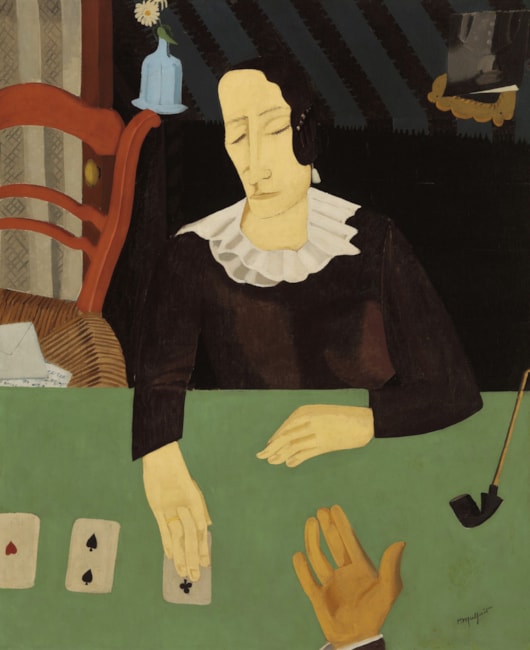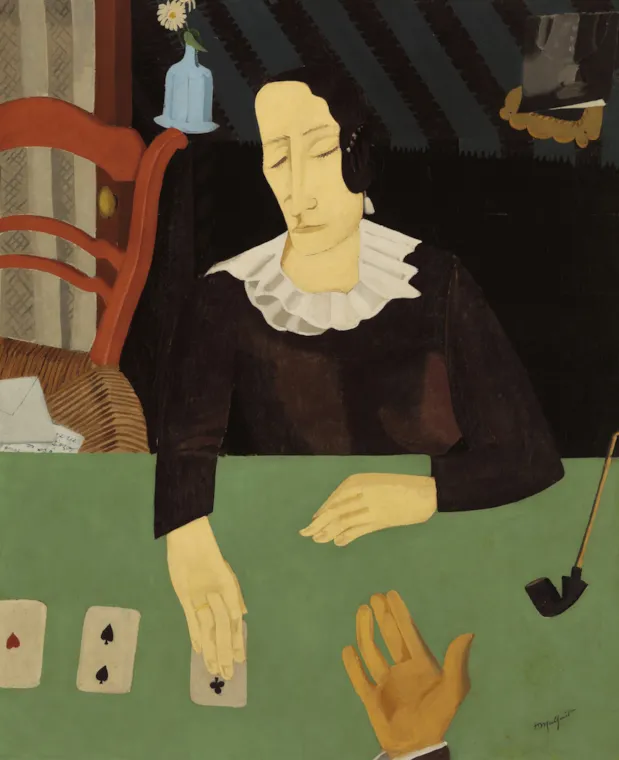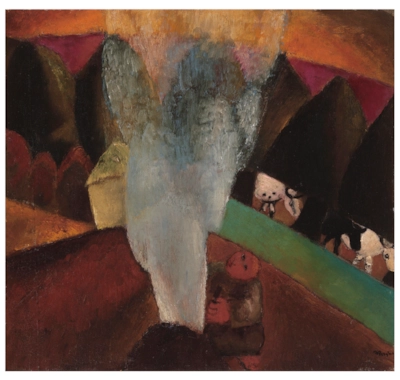Hubert Malfait
(1898 - 1971)
The fortune teller
1927
Oil on canvas
110 x 90 cm (43 ¹/₄" x 35 ³/₈")
Framed: 112.5 x 132.5 cm (44 ¹/₄" x 52 ¹/₈")
Signed lower right: HMalfait
Oil on canvas
110 x 90 cm (43 ¹/₄" x 35 ³/₈")
Framed: 112.5 x 132.5 cm (44 ¹/₄" x 52 ¹/₈")
Signed lower right: HMalfait
- Georges Marlier, Antwerp.
- Georges Giroux, Brussels, 29.10.1952.
- Georges Giroux, Brussels, 16.06.1953.
- Georges Giroux, Brussels, 29.10.1952.
- Georges Giroux, Brussels, 16.06.1953.
The fortune-teller is part of Hubert Malfait's masterpieces from his Cubist Expressionist period from 1925 to 1929. It is a strong work that places itself within the Flemish expressionism of the 1920s and belongs to the top of his expressionism, stimulated by the climate of cubism in Europe. Malfait joins the forefront of this style and has its own input in terms of invoice, color and spirit. The painter thus practices his own expressionism, linked to his environment and theme, purified from everyday reality. Constructivist-pictorial, coloristic and spiritual, the painter enters the (art) world from his village. Malfait has always been noticed for his sense of proportion, both in terms of design and use of color. The figures are the concept with the symbols of his world: thoughtful, poetic and ironic. This flat painted work is not about a situation, like his previous works from the period 1924-26, but is a representation that has been worked out symbolically. The subject of The fortune-teller has been lifted from reality and surrounded by referring motifs. The references are reminiscent of Chagall with poetic force. Sometimes, as in this work, spiced with light humor or irony. Compared to his works from the years before, in The fortune teller the coloristic harmony has been enhanced and very daring. The clear tones and sharply defined objects create a surreal world that recalls contemporary paintings by Gustave Van de Woestyne. The central and extremely serene motif of the cartomancer - immersed in the game - is roughly disturbed by the outstretched, questioning hand of a man who is outside the picture plane. The seemingly quiet simplicity in this work carries a charged mystery.
- Brussels, Galerie Le Centaure, Hubert Malfait - A. De Kat, 7-18.05.1927, no. 15.
- Liège, Feestzaal, Salon de 1929, 4-23.05.1929, no. 295.
- Venice, XVIIe Esposizione Biennale Internazionale d'Arte 1930, no. 60 (as 'La Cartomante').
- Brussels, Palais des Beaux-Arts, Exposition Malfait, 1932.
- Deinze, MuDeL, Hubert Malfait 1898-1971, 25.09-28.11.2004, no. 17.
- Liège, Feestzaal, Salon de 1929, 4-23.05.1929, no. 295.
- Venice, XVIIe Esposizione Biennale Internazionale d'Arte 1930, no. 60 (as 'La Cartomante').
- Brussels, Palais des Beaux-Arts, Exposition Malfait, 1932.
- Deinze, MuDeL, Hubert Malfait 1898-1971, 25.09-28.11.2004, no. 17.
- 17. Esposizione Internazionale d’Arte della città di Venezia: catalogo, 2. ed. (Venice: 1930), p. 243, no. 60 (as 'L'uomo e l'accordatore').
- De Ridder, A., "Hubert Malfait," in: Sélection (Antwerp: May-June 1927), p. 628 (ill.).
- Van Hoogenbempt, A., "De Nieuwe Generatie - Hubert Malfait," in: Kunst, jrg. 5, nr. 2-3 (Ghent: 1934), p. 64, 68.
- Peeters, D., Hubert Malfait (Antwerp: 1978), p. 10.
- De Smet, J., Sint-Martens-Latem en de kunst aan de Leie 1870-1970 (Tielt/Zwolle: Lannoo/Waanders, 2000), p. 263, 321, 344 (ill.).
- Van Doorne, V. & P. Vanrobaeys, Hubert Malfait 1898-1971, cat. (Deinze: Museum van Deinze en de Leiestreek, 2004), p. 53, no. 17 (ill.).
- Malfait, S. & P. Vanrobaeys, Hubert Malfait: oeuvrecatalogus (Tielt: Lannoo, 1986), p. 47-48, 102, no. 51 (ill.).
- Pauwels, P.J.H., Comme un moroir étincelant (Sint-Martens-Latem: Galerie Oscar De Vos, 2019), p. 262 (ill.).
- De Ridder, A., "Hubert Malfait," in: Sélection (Antwerp: May-June 1927), p. 628 (ill.).
- Van Hoogenbempt, A., "De Nieuwe Generatie - Hubert Malfait," in: Kunst, jrg. 5, nr. 2-3 (Ghent: 1934), p. 64, 68.
- Peeters, D., Hubert Malfait (Antwerp: 1978), p. 10.
- De Smet, J., Sint-Martens-Latem en de kunst aan de Leie 1870-1970 (Tielt/Zwolle: Lannoo/Waanders, 2000), p. 263, 321, 344 (ill.).
- Van Doorne, V. & P. Vanrobaeys, Hubert Malfait 1898-1971, cat. (Deinze: Museum van Deinze en de Leiestreek, 2004), p. 53, no. 17 (ill.).
- Malfait, S. & P. Vanrobaeys, Hubert Malfait: oeuvrecatalogus (Tielt: Lannoo, 1986), p. 47-48, 102, no. 51 (ill.).
- Pauwels, P.J.H., Comme un moroir étincelant (Sint-Martens-Latem: Galerie Oscar De Vos, 2019), p. 262 (ill.).
You May Also Like
Hubert Malfait
(1898 - 1971)
The fortune teller








